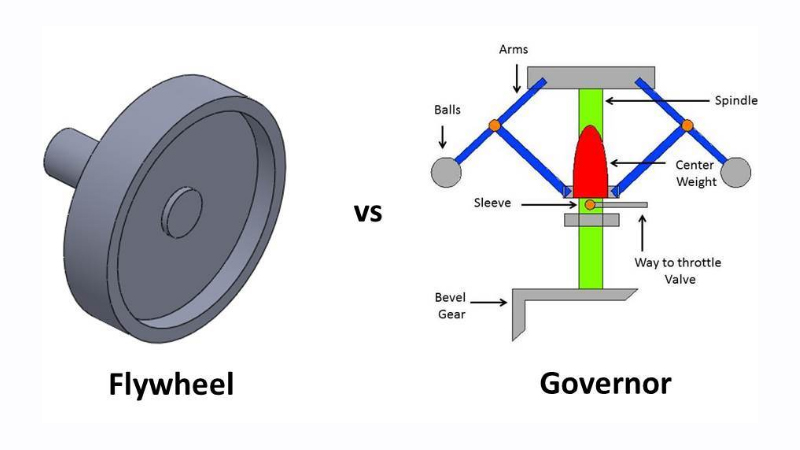
Sia il volano che il regolatore sono dispositivi meccanici utilizzati principalmente per lo stesso scopo; cioè controllare o regolare le fluttuazioni di velocità ad eccezione del punto di impatto.Mentre un volano regola la variazione di velocità all'albero a gomiti, il regolatore controlla la variazione di velocità causata dalla variazione di carico.Prima di tutto comprendiamo le applicazioni del volano e governatore e poi arriveremo alle differenze.
VOLANO:
Un volano è una ruota rotante pesante collegata a un albero rotante che attenua l'erogazione di potenza di un motore alternativo a causa della differenza tra la coppia motrice e la coppia attiva durante il ciclo di funzionamento.
Fondamentalmente, è un dispositivo meccanico progettato specificamente per immagazzinare energia rotazionale. Agisce come un serbatoio, nel senso che immagazzina energia quando la fornitura di energia è superiore a quella richiesta per il funzionamento e la rilascia quando la fornitura è inferiore al fabbisogno.
GOVERNATORE:
Un regolatore è anche un dispositivo meccanico che controlla la velocità media del motore quando ci sono variazioni del carico. È essenzialmente un dispositivo di controllo della velocità utilizzato per misurare e regolare la velocità della macchina indipendentemente dalle variazioni di carico. Mantiene la velocità del motore entro limiti specificati indipendentemente dalle variazioni di carico.
DIFFERENZA TRA VOLANO E GOVERNATORE:
RIEPILOGO:
Mentre la funzione di un volano è di regolare le fluttuazioni di velocità durante ogni ciclo, la funzione di un regolatore è di mantenere costante la velocità media del motore durante l'intero ciclo. Il volano immagazzina l'energia di rotazione quando l'energia meccanica fornita è superiore a quella richiesta per il funzionamento, mentre un regolatore regola l'alimentazione del carburante in base alle condizioni di carico variabili. Sebbene ipoteticamente entrambi abbiano lo stesso scopo, ovvero il controllo della velocità, lo fanno in modo molto diverso. La principale differenza risiede infatti nel punto di impatto
Both flywheel and governor are mechanical devices used mostly for the same purpose; that is to control or regulate the fluctuations in speed with the exception of the point of impact.While a flywheel regulates the variation of speed at crankshaft, governor controls the variation of speed caused by load variation.Let us first understand the applications of flywheel and governor and then we will come to differences.
FLYWHEEL:
A flywheel is a heavy rotating wheel attached to a revolving shaft that smooths out the delivery of power of a reciprocating engine due to the difference between the driving torque and the active torque over the cycle of operation.
Basically, it’s a mechanical device specifically designed to store rotational energy. It acts as a reservoir, meaning it stores energy when the supply of the energy is more than that is required for the operation and releases the same when the supply is less than the requirement.
GOVERNOR:
A governor is also a mechanical device that controls mean speed of the engine when there are variations in the load. It’s essentially a speed-controller device used to measure and regulate the speed of the machine irrespective of the load variations. It maintains the speed of the engine within specified limits regardless of load variations.
DIFFERENCE BETWEEN FLYWHEEL AND GOVERNOR:
SUMMARY:
While the function of a flywheel is to regulate the fluctuations of speed during each cycle, the function of a governor is to keep the mean speed of the engine constant throughout the entire cycle. Flywheel stores rotational energy when the mechanical energy supplied is more than that’s required for operation, whereas a governor regulates the fuel supply according to the varying load conditions. While hypothetically both serve the same purpose, that is speed control, they do it very differently. The main difference in fact lies in the point of impact

- Log in to post comments